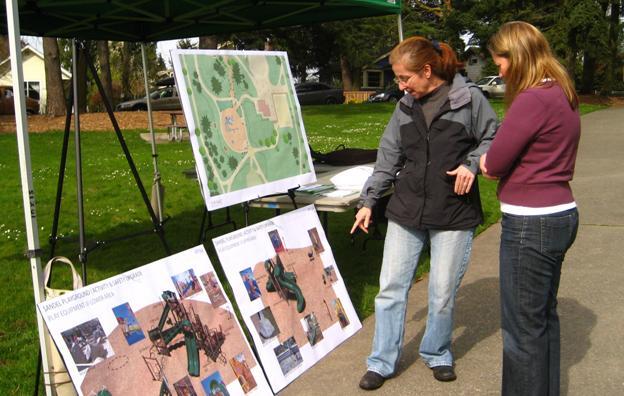Greenwood group pushing for Sandel Park skatedot
Community organizer and founding member of Parents for Skate Parks Kate Martin, left, views plans for the Sandel Park remodel at a March 27 open house. The design for the park does not include a skatedot.
Mon, 04/05/2010
There used to be a skate ramp in Kate Martin’s front yard. Her sons had just caught the skateboarding bug, and the mini-ramp, planted among the maples and mountain hemlocks, became an icon in their south Greenwood neighborhood.
“It was heaven,” said Martin, a longtime community organizer who owns her own site planning, design and construction management business. “Every little kid on my block came and played on our stuff. Older kids, pro skaters—the gamut – would stop by. It’s just a safe place to play.”
When a lawsuit forced the ramp’s removal last spring, Martin, one of the founding members of Parents for Skate Parks, took a sabbatical from activism.
But now, as nearby Sandel Park heads toward a redesign, she’s reloaded and is pushing for a skatedot—a mini-ramp measuring less than 1,500 square feet—in her neighborhood.
There’s just one speed bump: There isn’t room in Seattle Parks and Recreation’s budget to fund it.
Sandel Park is identified in the Citywide Skatepark Plan as a site that could accommodate a skatedot. But, the Parks and Green Spaces Levy that passed in 2008, allocating $146 million to renovate Seattle parks, earmarked only $350,000 to remodel the Sandel play area with top-of-the-line equipment.
“The scope and budget for the project doesn’t allow a very big skate element,” said Dewey Potter, public information manager for Seattle Parks and Recreation. “We can’t do everything at once, unfortunately, as much as we would want to.”
To the citizens’ committee that put together the levy, the lackluster play area with a couple swings and dingy climbing structure seemed in most desperate need of renovation.
Since Parks hopes to break ground on the project in late spring, Potter said it is too late in the process to add in a skatedot, and the group will need to pursue a different route.
Potter identified three options for Parents for Skate Parks and other skate supporters: raising money on their own, waiting for the next round of an opportunity fund or applying for a Neighborhood Matching Fund.
If they can’t rally enough funding this year, it could take years before the project comes to fruition.
Martin thinks there is a larger issue on the line. The play area renovation is directed for younger kids, primarily under the age of 12. There isn’t too much for teens to do at the park, which is why she’s pushing for the skatedot, she said.
“Skateboarding is extremely popular, and the majority of kids today probably at least go through a skateboarding phase,” said Sally Roepke, a technician at the Fred Hutchinson Cancer Research Center who has been skateboarding since the age of 15. “I know there are plenty of Greenwood kids into skateboarding. I see them out skating down my street on any sunny day.”
Roepke lives a few blocks from Sandel Park, so she admits the skatedot would be convenient for her. But she cares more about a younger crew of skaters.
Though Roepke said she thinks all four of Seattle’s major skate parks are great outlets for the sport, she’s found they can be inaccessible and fail to serve young children who are just testing their wheels and may be intimated by a bigger, older crowd—just like Roepke was when she learned to skate.
“A small neighborhood skatedot like the proposed mini-ramp at Sandel would [provide] an accessible, easy and safe place for kids to skate,” Roepke said. "I've made a ton of friends skateboarding, and it's one of the most positive things going on in my life. I'd love to see this resource for younger kids here in Greenwood.”
Many also hope that a flux of park visitors would deter drug activity that is a frequent problem in the area.
For Martin, the conversation centers on defining what a playground is and who it is for.
“A lot of our money for parks upgrades of any kind are playground-oriented,” Martin said. “If … little kids had to go through their own process, that would seem bizarre to people.”
Though Potter cited teen programs and community centers as activities for teens, Martin said she thinks these are too vague and don’t offer the permanence of a skate ramp.
She plans to seek funding elsewhere, driven by her belief that older kids need a safe, local place where they can hang out, have fun and skate. Her sons call it "chilling."
“‘Chilling’ is a big business for kids,” Martin said. “If they’re doing it in the park, that’s great. They’re big, they’re loud, they’re teens, but they belong there just as much as the people with the strollers.”


